|
Location:
San Juan Teotihuac�n,
Mexico. |
Grid Reference: 19�
42' N, 98� 51' W. |
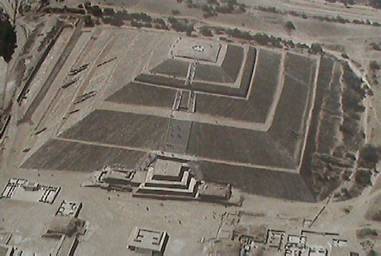  Teotihuac�n
:
(City of the Gods).
Teotihuac�n
:
(City of the Gods).
The original builders of
the complex are unknown, but it is suggested by Spence
(1), that it was the
Mecca of the Nahua. The city was left abandoned in 700 AD.
It was suspected by Stansbury Hagar that the city had been built as a 'map of heaven'. During
the 1960's and 1970's a comprehensive mathematical survey was carried out by
Hugh Harleston Jr, who found that the principle structures line up along the
'Street of the dead' (and beyond), from which he concluded the city was
a precise scale model of the solar system, including Uranus,
Neptune and Pluto (not rediscovered until 1787, 1846 and 1930
respectively. (21).
(Click here for map of the site)
Teotihuacan means 'The City of the Gods", or "Where Men
Become Gods" (in Nahuatl).
Although not much is known about the earliest phase of Teotihuacan, From the
Tzacualli to Miccaotli phases; A.D. 1-200, which were
characterized by monumental construction, Teotihuacan quickly became the
largest and most populous urban center in the New World. Teotihuacan was the
sixth largest city on the world during its period of greatest prosperity,
according to an estimated population of 125,000 (Millon 1993:33). The city
seems to have functioned for centuries as a well-developed urban centre
until its sudden collapse, sometime around the 7th cent AD.
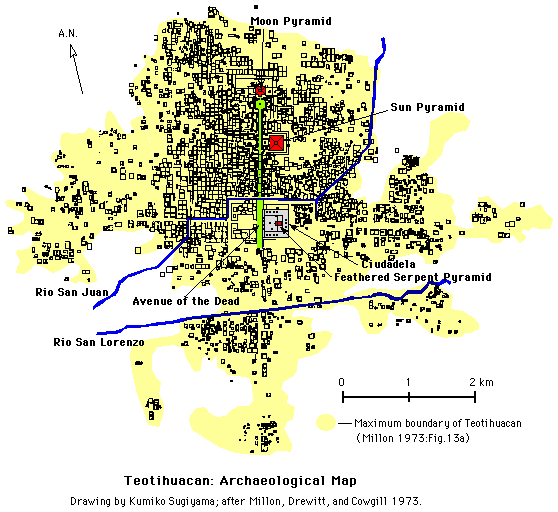
The Avenue of the dead -
Running south from the Pyramid of the moon for about 3.2 km,
where it was bisected by an east-west Avenue of equal length. Along it are a
series of open courtyards', each up to 145m wide and lined with small
platforms.
(12).
The Avenue of the Dead
was the main street of Teotihuacan. It ran south for more than 3km,
beginning at the Moon Plaza and extending beyond the Ciudadela and the Great
Compound complexes to the south. According to Millon (Cowgill 1992a:96;
Millon 1981:221), the avenue continued even further south, terminating near
the edge of the mountains on the distant horizon.
A large, long drainage
channel ran under the floor of the avenue gathering rain water from
neighbouring architectural units and draining it into Rio San Juan.
There are two larger
pyramids and one smaller at Teotihuacan. The smaller one, called 'The
Pyramid of Quetzalcoatl' or the 'Pyramid of the Feathered
Serpent' is now considered to be the most important of the
three. A series of tunnels have been found underneath it in
2010. They are thought to be the resting place of the Ruling
elite.

The layout is often compared to the pyramids at
Giza (left), and Orion (centre).
(It is noticeable that there are also several triple-circles in England which
share the same layout)
(More on the Subject of Triple
Circles)
The
Pyramid of the Sun:
The largest of the Teotihuac�n pyramids, the
pyramid of the sun was actually reconstructed as five stepped platforms.
However, the forth platform seems to have been erroneously reconstructed by
Batres following his heavy-handed excavations in 1907. The pyramid
originally consisted of four stepped platforms, a surmounting temple, and
the Adosada platform, which was built over what was originally the principal
facade of the pyramid. No information about the temple itself is available,
since, along with the upper-most portion of the pyramid, it has been
completely destroyed.

(Photo Credits:
montagesinmexico.wordpress.com)
The top storey temple containing a great image of the sun carved from a
rough block of stone. In the breast was inlaid a star of the purest gold,
which was later seized by the followers of Cortes
(1).

Physical statistics:
Alignment -
Orientated several degrees east of True North.
Height - 233.5 ft
(21), 230 ft
(12),
Angle of side - 43.5�
(21)
Perimeter of base - 2932.8 ft
(21)
Length of side - 233.5 m
(21), 225m
(12).
The dimensions of the Pyramid
of the Sun incorporate 'Pi' in the following way: (4 x Π) x h =
Perimeter / Circumference of base. (21)
The pyramids base
area is almost the same as that of the great pyramid of
Ghiza.
(21),
(12),
The height is almost half.
It was discovered in 1971, that leading from a natural cave,
6m below the pyramid, and running for approx' 100m to the east, is a natural
passageway. (12). It opens close under the centre
of the Pyramid into a 'four-leaved-clover' shape, each 'leaf', about 60 ft
in circumference and containing beautifully engraved slate discs and highly
polished mirrors. There was also a complex drainage system of interlocking
segments of carved rock pipes. (21).
Mexico's first
great city, Teotihuacan coalesced out of a number of small
hamlets in the early years of the first century B.C., after, as
archaeologists believe, the discovery of a four-chambered
lava-tube cave in the Teotihuacan Valley. Caves played an
integral role in Mesoamerican religion, being places of
emergence of gods and ancestors as well as portals to the
underworld, the world of demons and other potent beings. The
Teotihuacan cave may have held particular significance, its four
lobes representing the four parts of the Mesoamerican cosmos. It
soon became a focal point of ritual activity and settlement in
the valley. Teotihuacan's Pyramid of the Sun was built directly
over the cave in the second century A.D.
(2)
Article: Feb: 2013: (LaTimes.com)
'Mexico finds
Fire-God Figure at top of Pyramid of the Sun'
'Mexican
archaeologists announced this week that a figure of the god,
called Huehueteotl, was found in a covered pit at the apex of
the Pyramid of the Sun at Teotihuacan. The discovery suggests
that a long-disappeared temple at the top of the pyramid was
used to perform ritual offerings to the fire god, Mexico's
National Institute of Anthropology and History, or INAH, said in
a statement Monday. Archaeologists found the Huehueteotl, along
with two stone pillars, in a covered pit about 15 feet deep, at
a height of about 214 feet from the ground. The pit is below the
remnants of a platform at the top of the Pyramid of the Sun that
probably served as the foundation for a temple'.
(Link
to Full Article)
Article: Feb, 2012
(PressTV)
'Jade Mask discovered in Pyramid of the Sun'
Archaeologists have discovered
a jade funerary mask during their excavations under the pyramid
of the sun. The mask was part of an 'offering' found under the
pyramid,
seven human burials including children who were buried before
the construction of the building. 'Several numbers of
obsidian artefacts were also found including projectile heads
and small knives along with an anthropomorphic eccentric
artefact and three anthropomorphic figurines with shell and
pyrite eyes'.
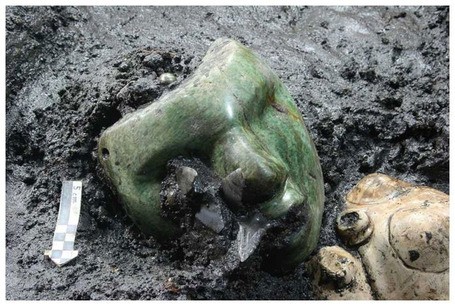
The discovery of
an Olmec Jade mask 'beneath' the pyramid suggests a cultural
connection between the Olmecs and the
original builders. The archaeologists also determined that
'During
excavating the tunnel into the heart of the pyramid three
architectural structures were discovered that are older than the
current Pyramid of the Sun'
(6). Future
analysis of these structures will undoubtedly better our
understanding of the origin of the Teotihuac�n complex itself.
The Pyramid of the Moon:
The
Moon Pyramid is located at the northern end of the Avenue of the Dead, which
was the main axis of the city. A similar edifice as
the Pyramid of the sun, but smaller in scale, built in the second half of
the 2nd century AD. According to Aztec tradition it was once
surmounted by a 20 ton statue. (12).
The Pyramid of the moon was an integral part of the complex, being built
into the landscape as the following picture demonstrates.

The pyramid of the moon
facing North: The peaks of 'Cerra gordo' and the pyramid coincide.
The Cerro Gordo ("Fat
Hill"), was a sacred mountain just north of the site associated with the
goddess cult and the region's fertility.
The Chambers of the Pyramid of
the moon:
Article.
(Archaeology. Dec 4. 1998)
'A burial chamber
containing what may be the remains of a retainer of an early
ruler of Teotihuacan, an ancient metropolis 30 miles northeast
of Mexico City, has been found within the Pyramid of the Moon,
at the northern end of the site's main thoroughfare, the Street
of the Dead. Discovered by Arizona State University (ASU)
archaeologist Saburo Sugiyama, the skeleton, thought to be that
of an adult male who was bound and sacrificed, was buried in a
square chamber 11.3 feet on each side and five feet deep. He was
surrounded by more than 150 burial offerings, including obsidian
and greenstone figurines, obsidian blades and points, pyrite
mirrors, conch and other shells, and the remains of eight birds
(hawks or falcons) and two jaguars, which may have been buried
alive. "The quality of the offerings," says Sugiyama, "is
exceptional, particularly in light of the more than 1,200
burials found at the site so far."
The
discovery of pyramid funerary remains is in keeping with
discoveries at Mayan centres of Palenque and Copan.
The grave, which dates to about
A.D. 150, is associated with pyramid's fourth construction
phase. What we see today is the fifth and last, built ca. A.D.
250. "The pyramid of the Moon," says Sugiyama, "started out as a
rather small temple beneath what is now the five-tiered platform
in front of the pyramid. After two additional construction
episodes, the builders embarked on the construction of the
pyramid itself." (2)
Temple of Quetzalcoatl
(The Pyramid of the Feathered Serpent).
A six-stage pyramid with a height of 72 ft, and a base area
of 82,000 ft.
It is located in the Ciudadela
at the southern end of the avenue of the dead.
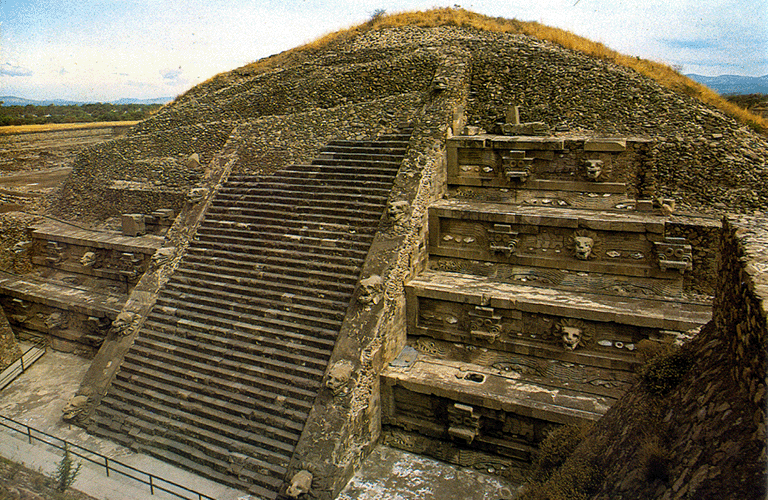
This pyramid was built over existing structures, and has
been built over since by the 'Adosada', which was integrated into the design
of the original temple, archaeology has re-exposed the original temple of
the feathered serpent, upon which can be seen the numerous 'feathered
serpents' heads carved into the temples facade and stairwell.
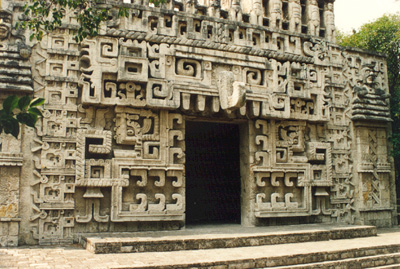 A
prehistoric structure had been buried beneath a much later mound immediately
in front of it. The exposed temple still had traces of multicoloured
paintings on the rows of rectangular panels superimposed on the sloping
walls with sculpted serpent heads lining the sides of the stairway and
facing blocks.
(21). A
prehistoric structure had been buried beneath a much later mound immediately
in front of it. The exposed temple still had traces of multicoloured
paintings on the rows of rectangular panels superimposed on the sloping
walls with sculpted serpent heads lining the sides of the stairway and
facing blocks.
(21).
Several mass graves,
excavated between 1982 and 1989, were found around and beneath the Temple of
the Feathered Serpent (Quetzelcoatl) at the southern end of the site. The
137 people buried there were apparently sacrificed, their hands tied behind
their backs, during the construction of the pyramid.
(2)
(The Feathered
Serpent in Mythology)
Article, (Aug 2010):
Tunnel System Uncovered at the Pyramid of the Feathered Serpent.
 'Following
8 months of investigative work, archaeologists of the National
Institute of Anthropology and History (INAH) located, 12 meters
below, the entrance to the tunnel that leads to galleries under
the Feathered Serpent Temple, in Teotihuacan. 'Following
8 months of investigative work, archaeologists of the National
Institute of Anthropology and History (INAH) located, 12 meters
below, the entrance to the tunnel that leads to galleries under
the Feathered Serpent Temple, in Teotihuacan.
The tunnel
passes under the Temple of the Feathered
Serpent, the most important building of the
Citadel, �and the entry was located a few meters
from the pyramid. A vertical shaft of almost 5
meters by side is the access to the tunnel: it
goes 14 meters deep, and the entrance leads to a
nearly 100 meters long corridor that ends in a
series of underground galleries excavated in the
rock.
The tunnel was
discovered in late 2003 by Sergio Gomez and
Julie Gazzola, but its exploration has required
several years of planning and managing the
financial resources necessary to carry out
research at the highest scientific level.
So far, 200 tons of earth have been withdrawn,
he said, while doing this we have found about
60,000 pieces of artefacts and pottery.
�Several
indications suggest that
access to the underground
passage was closed between
200 and 250 AD, probably
after depositing something
inside. One of the
hypotheses postulate that,
within the large chamber
detected by the GPR, we
could locate the remains of
important people in the
city. �
The
investigations have led to know
with certainty that this tunnel
was made prior to the
construction of the Temple of
the Feathered Serpent and the
Citadel. The tunnel is
contemporary with a large
architectural structure, which
could be a ball game court,
according to the form of the
ground. According to the
hypothesis about the meaning and
symbolism of the tunnel,
archaeologist Sergio Gomez, said
the tunnel had to be linked to
concepts related to the
underworld, hence it is possible
that in this place were carried
out initiation rituals and the
divine investiture of
Teotihuacan rulers, since the
power was acquired in these
sacred spaces.
the excavation
have permitted to recuperate
thousands of small ornaments,
made of shell, jade from
Guatemala, serpentine, slate and
obsidian, thrown by the people
from Teotihuacan as offerings at
the moment of closing the
entrance. Several parts of a
frieze that may have decorated a
building prior to the Temple of
the Feathered Serpent, and that
was dismantled, have been found
as well'.
(5)
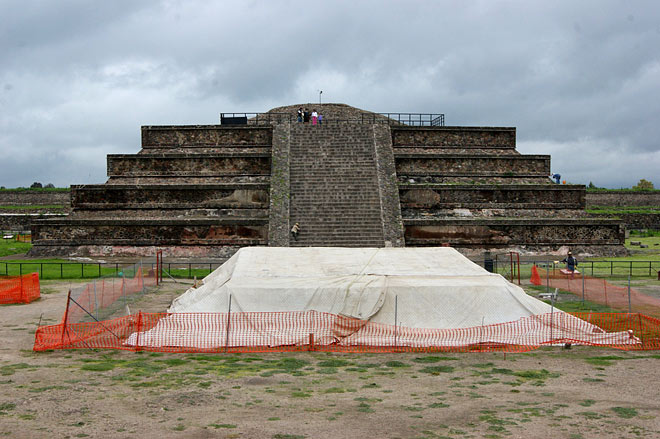
�
Photo: DMC, INAH. Photographer:
Mauricio Marat
(Press release of the National
Institute of Anthropology and
History (INAH), Mexico, 3 August
2010)
"It is
possible," concluded Sergio
G�mez, "that the tunnel
discovered would have been the
most important and sacred
element around which the first
constructions were undertaken on
this site about 100 B.C., and
where later on The Citadel was
erected, which was the
magnificent stage where rituals
associated with the myths of
creation and the beginning of
the mythic time must have been
performed."
(MailOnline:
June, 2011).
120m tunnel discovered, believed
to lead to rulers burial
chambers.
(Other
Prehistoric Underground
Structures)
|
The Mica
Temple:
Following the discovery of mica in the Pyramid of the Sun,
two more sheets, approx' 90 ft square, and laid directly on top of one
another, were discovered beneath the stone paved floor of the Mica temple.
Trace element testing showed it to originate 2000 miles away in Brazil.
(21)
Similar finds of Mica have been found at some Mayan sites.
The first sheets of mica
were found in between two of the upper levels of the Pyramid of the Sun. The
discovery occurred in 1906, when the complex was restored. But the mica was
removed and sold as soon as it had been excavated, by Leopoldo Batres, the
man in charge of the project.
More recently, a �Mica Temple� has been discovered on the site, but this
time, the mica has remained in situ. The temple sits around a patio about
300 metres south of the west face of the Pyramid of the Sun. Directly under
a floor paved with heavy rock slabs, they found two massive sheets of mica.
The sheets are 90 feet square and form two layers, one laid directly on top
of the other. As it sits underneath a stone floor, its use was obviously not
decorative, but functional.
Mica is a substance containing different metals, depending on the kind of
rock formation in which it is found. The type of mica found at Teotihuac�n
indicates a type that is only found in Brazil, more than 2000 miles away.
The same South American mica was found in Olmec sites. It is clear that its
presence in Teotihuac�n involved a lot of effort � and it thus must have
played an important role
As yet there is no satisfactory
explanation as to how the Mica sheets (up-to 30cm thick) were transported
there over 2000 Miles, nor their significance or purpose in relation to the
complex or pyramids.
According
to most sources the mica is said to originate from a source in Brazil, over
2000miles distant (suggesting transport by boat), for Example,
Childress (3)
says of it 'According to expert opinions the mica found at Teotihuac�n is a
type found only in faraway Brazil', While Fagan
(4),
calls it 'locally mined mica'. The jury is out on this one.
Mica is used by the electronics industry in
capacitor construction, Thermal and electric insulation, Opaque to fast
neutrons, and it acts as a moderator in nuclear reactions.
(Other
Examples of Electricity
in pre-history)
|
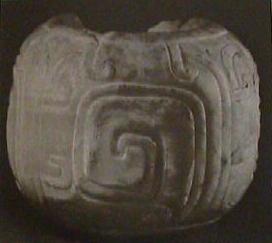
The
marks inside this stone cylinder suggests that it was drilled, providing yet
another example of the advanced masonry skills in the pre-Columbian
America's.
|
Archaeoastronomy at Teotihuacan.
It is a curious fact that the city of Teotihuac�n
was meticulously laid out on a grid which is offset 15�.5 from the
cardinal points. Its main avenue, the "Street of the Dead," runs from
15�.5 east of north to 15�.5 west of south, as does its most impressive
structure, the Pyramid of the Sun, which is directly oriented to a point
15�.5 north of west.
(Archaeoastronomy) |
|









 'Following
8 months of investigative work, archaeologists of the National
Institute of Anthropology and History (INAH) located, 12 meters
below, the entrance to the tunnel that leads to galleries under
the Feathered Serpent Temple, in Teotihuacan.
'Following
8 months of investigative work, archaeologists of the National
Institute of Anthropology and History (INAH) located, 12 meters
below, the entrance to the tunnel that leads to galleries under
the Feathered Serpent Temple, in Teotihuacan.